Learn Them All in Minutes: Six Essential Wiring Skills
by Guest Post on Apr 27, 2012
Overview of Electricity
Just about anyone can do basic home wiring. If you're careful about connections and follow a few commonsense safety tips, wiring is among the most predictable, pleasant parts of construction. And you're never long in doubt whether you've wired things correctly. If you goof, a fuse or a breaker trips harmlessly; if you do it right, bulbs shine and radios play.
Take a few minutes to review the essential wiring skills shown on the following pages. Many have helpful animations that show you exactly what happens as you work. Even if you're an old hand at home improvement, chances are you'll find a useful tip you haven't seen before. If you're a beginner, these how-tos will set you on the right path in a hurry.
|
First, find the main service panel. It's probably located on an exterior wall near the point at which power lines enter your house. Look for wires running from a telephone pole to the weatherhead near the eaves. You'll probably see a 2- or 3-inch conduit running down from it into the panel. Panels are also found in attached garages and, especially in older homes, in basements. Next, open the panel door. In a newer home or one that's had its service upgraded, you'll see circuit breakers, which look rather like large light switches. (If yours is an older home, you may see cartridge or screw-in fuses.) Most newer panels have two large breakers at the top and a column or two of smaller breakers for individual circuits. Now to shut off a circuit. If you're lucky, you'll find a chart inside the panel door that identifies the area each breaker controls. Most of us, alas, will have to find the target circuit by trial and error. |
Here's how to turn off circuits in your wiring1. Have a helper test circuits in the room where you'll be working, while you stay at the entrance panel. Your helper can flip light switches or plug a voltage tester into receptacles to see if the power's on or off. 2. Switch off breakers or unscrew fuses in the main panel until the tester's light (or the fixture controlled by the switch) goes out. As you identify each room or circuit, label the breaker (or fuse) that controls it. 3. To be safe, completely remove the fuse from the panel, or tape the breaker in the OFF position while you're working on the circuit. 4. To turn the power back on, simply flip the breaker from OFF to ON (or replace the fuse). Safety: The lights in a given room may be on a different circuit than the receptacles, especially in an older home or any home where wiring changes have been made over time. Don't assume that, having found the breaker for one device in a room, you've found them all. Always test a device before you work on it, and be sure the power is off. |
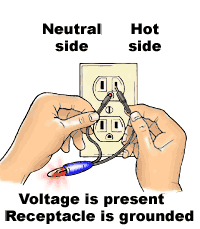
Never assume that the power to a fixture, receptacle, or circuit is off. Testing for a live current.Always test an electrical device before you begin working on it. The easiest, least expensive way to do so is with a voltage tester, shown here. If you don't have one, buy one. It can save your life. To use a voltage tester, simply plug its leads into a receptacle, or, if the cover plats off, touch them to the screw terminals of the device. (Be careful not to touch the bare-metal leads themselves, however, or you may get shocked.) If current is present, the tester will light. Also touch one tester lead to the grounding wire or grounding screw, and the other lead to each socket, wire, or terminal in turn.
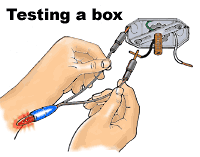
Testing for continuityThe continuity tester has a battery in it, so it can apply a low-voltage current to devices and circuits even when the main power is off. This tool lights up when continuity - a complete circuit, in other words - is detected. Use it to identify which wire is sending current where and to find breaks in circuits. The best models sound a tone and/or vibrate, allowing you to keep your eyes on the probe tips as you work. |
|
Tip: Keep a variety of sizes of twist-on wire connectors on hand. The two most commonly used sizes are color-coded yellow and red. Note: All electrical connections must be housed in an approved work box, and all electrical cables must be anchored to an electrical box, and nailed to framing within 6 inches of the box. Safety: It's unsafe to extend a circuit by splicing a thicker-diameter wire onto a thinner one. Someone unfamiliar with the extension may assume that the entire circuit is of the heavier wire and overload it. Old House: The knob and tube wiring typical of an old house often has many soldered splices wrapped with electrical tape. These splices are common in attics and basements, and they're usually safe if left undisturbed. If your local code permits you to tie into a knob-and-tube circuit, however, you must make the connection in a junction box. |
Popular Articles
Three Places to Spend Money on the Exterior of Your Home
When you have the exterior of your home remodeled, you are investing, time, energy and convenience into the project and you want to make sure that...
94877 Views
Homemade Headboards-Make an Upholstered or Wooden Headboard
Homemade headboards can add a lot of personality to any bedroom. They can be coordinated with existing furniture and room decor or they can be the...
74282 Views
When to Use a Brush, Roller or Sponge Brush
Brushes are a good choice for painting trim and woodwork. They are also useful for cutting in the edges around the top and bottom edges and corners...
71738 Views
Creating a Cottage Kitchen with Bead Board
Kitchen decor can range from modern and bold to elegant and elaborate by using strategic kitchen pieces. One of the most popular decorating trends...
52726 Views
Gas Fireplace Diagnostics and Troubleshooting
Follow these steps for diagnosing and troubleshooting Gas Fireplaces repairs. For the average DIYer, this may seem intimidating, depending on the...
30571 Views
Latest Articles
10 Concrete Patio Ideas on a Budget
A concrete patio can be a game-changer for your outdoor space. It is durable, versatile, and can be customized to fit your style. But what if you...
on Mar 25, 2025
Tips for Creating a Stunning Personalized Photo on Canvas
Order the unique beauty of a personalized photo on canvas and bring your memories to life. With a customized photo on canvas, you can transform...
on Mar 7, 2025
Best Areas to Buy Property in Singapore for Long-Term Growth
Singapore's real estate market remains one of the most stable and lucrative in the world. With limited land supply, strong governmental...
on Feb 18, 2025
Troubleshooting Excess Water in Your HVAC Secondary Condensate Drain Pan
When maintaining your air conditioning system, it is easy to overlook the condensate drain pan - until excess water starts pooling in places where...
on Jan 12, 2025
Real Estate Investment Trusts (REITs): A Beginners Guide
By combining the advantages of stock market and real estate investing, Real Estate Investment Trusts, or REITs, offer an alluring investment...
on Dec 19, 2024
Featured Articles
What Type of Licensed Contractor Should You Hire?
on Feb 28, 2017
Hire Contractors / Estimates

Looking for a specialty project? There are many types of contractors available for your home improvement needs. Finding the right type of...
Sponsored Articles
Best Areas to Buy Property in Singapore for Long-Term Growth
on Feb 18, 2025
Real Estate / Finance

Singapore's real estate market remains one of the most stable and lucrative in the world. With limited land supply, strong governmental...
Actions
Top Categories
- Garden / Landscaping / Patio — 264
- Kitchen / Bathrooms — 240
- Real Estate / Finance — 203
- Appliance / Repair — 186
- Interior Design / Decor — 184
- HVAC / Air Conditioning — 148
- Cleaning / Maintenance — 144
- Improvements / Remodeling — 131
- Plumbing / Basements — 118
- Floors / Tile / Hardwood — 116
- Doors / Garages — 113
- Safety / Security — 113
Articles Archive
More DIY Articles
Why You Need to Hire a Licensed and Insured Sandblasting Contractor
Trusting sandblasting to a licensed and insured contractor is another way of saying that you will be relying on a measure twice, cut once type of...
Some Office Improvement Tips to Help You Remodel Your Office
Office renovation is necessary if you want to keep your office looking its best and also if you want to motivate your staff. You can redesign your...
Top Reasons Why Steel Frame Homes Are the Future
Traditionally homes have been made from wood. This is because there was a plentiful supply of wood and it is comparatively easy to build with. Of...
Buying Secondhand Sea and Cargo Conex Containers Repurposed
A vast majority of people call them freight containers, sea cans, storage containers or bunker boxes but we call them Conex boxes. Did you know...
Top Tips for Choosing the Best Type of Roofing for Your New Home
When you are in the process of choosing a new roof for your home, there are a lot of different things that should influence your decision. There...

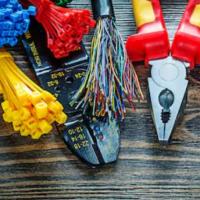
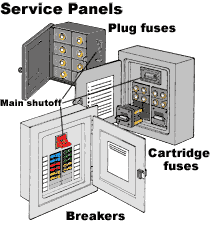 It's essential to know how to shut off all electricity to your home. By turning off individual circuits at the main service panel, you can work safely on any receptacles, lights and appliances in your home. Cutting the power is always useful when there's a gas leak or other emergency.
It's essential to know how to shut off all electricity to your home. By turning off individual circuits at the main service panel, you can work safely on any receptacles, lights and appliances in your home. Cutting the power is always useful when there's a gas leak or other emergency.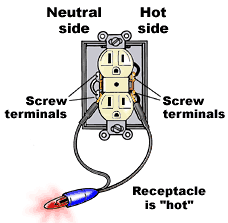 If you are working in an open electrical box, such as the ceiling box shown here, touch the voltage tester leads - carefully - to all possible wire pairs you find within, and to the box itself. When you're done, you will know whether it is safe to keep working--or whether it is time to go back to the main service panel, find the circuit that's still on, and shut it off.
If you are working in an open electrical box, such as the ceiling box shown here, touch the voltage tester leads - carefully - to all possible wire pairs you find within, and to the box itself. When you're done, you will know whether it is safe to keep working--or whether it is time to go back to the main service panel, find the circuit that's still on, and shut it off.